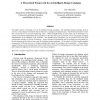1225 search results - page 9 / 245 » Design Principles for Intelligent Environments |
PERCOM
2003
ACM
14 years 9 months ago
2003
ACM
When building intelligent spaces, the knowledge representation for encapsulating rooms, users, groups, roles, and other information is a fundamental design question. Here we prese...
USENIX
2001
13 years 11 months ago
2001
Nickle is a vaguely C-like programming language for numerical applications, useful both as a desk calculator and as a prototyping and implementation language for numerical and sem...
EWC
2011
13 years 4 months ago
2011
This paper outlines continuing work on the intelligent design catalogue. The intelligent design catalogue seeks to create a virtual design environment that is linked to a catalogu...
AAAI
1994
13 years 11 months ago
1994
One of the original motivations for research in qualitative physics was the development of intelligent tutoring systems and learning environments for physical domains and complex ...
OZCHI
2005
ACM
14 years 3 months ago
2005
ACM
This paper describes research into the personalised delivery of information about an intelligent environment. The challenges we need to address are the dual forms of the Invisibili...

